Guides • Perfecting your Craft
Last updated on Sep 21, 2023
How to Write Fabulous Dialogue [9 Tips + Examples]
Tom Bromley
Author, editor, tutor, and bestselling ghostwriter. Tom Bromley is the head of learning at Reedsy, where he has created their acclaimed course, 'How to Write a Novel.'
View profile →Good dialogue isn’t about quippy lines and dramatic pauses.
Good dialogue is about propelling the story forward, pulling the reader along, and fleshing out characters and their dynamics in front of readers. Well-written dialogue can take your story to a new level — you just have to unlock it.
In this article, I’ll break down the major steps of writing great dialogue, and provide exercises for you to practice your own dialogue on.
Here's how to write great dialogue in 9 steps:
👀
Which dialogue tag are YOU?
Find out in just a minute.
1. Use quotation marks to signal speech
Alfred Hitchcock once said, “Drama is life with all the boring bits cut out.”
Similarly, I could say that good dialogue in a novel is a real conversation without all the fluff — and with quotation marks.
Imagine, for instance, if every scene with dialogue in your novel started out with:
'Hey, buddy! How are you doing?"
“Great! How are you?""
'Great! Long time no see! Parking was a nightmare, wasn’t it?"
Firstly, from a technical perspective, the quotation marks are inconsistent and incorrectly formatted. To learn about the mechanics of your dialogue and how to format it, we also wrote this full post on the topic that I recommend reading.
Q: Which authors are known for exceptional dialogue, and what techniques set them apart?
Suggested answer
I like Nick Hornby for providing realistic dialogue for male characters. He can get into the male mind and convey what men are thinking, in an honest and real way.
Melody is available to hire on Reedsy ⏺
You can't go wrong with Robert B. Parker's sharp, punchy dialogue. Chuck Palahniuk is also very good at keeping dialogue crisp. For both of these writers, they don't tend to use a ton of attributive dialogue tags—especially when there're only two people in a scene—and accompanying actions while dialogue is occurring is kept to a minimum, which retains that punchiness.
Brett is available to hire on Reedsy ⏺
Secondly, from a novel perspective, such lines don’t add anything to the story. And finally, from a reading perspective, your readers will not want to sit through this over and over again. Readers are smart: they can infer that all these civilities occur. Which means that you can skip the small talk (unless it’s important to the story) to get to the heart of the dialogue from the get-go.
For a more tangible example of this technique, check out the dialogue-driven opening to Barbara Kingsolver's novel, Unsheltered.
2. Pace dialogue lines by three
Screenwriter Cynthia Whitcomb once proposed an idea called the “Three-Beat Rule.” What this recommends, essentially, is to introduce a maximum of three dialogue “beats” (the short phrases in speech you can say without pausing for breath) at a time. Only after these three dialogue beats should you insert a dialogue tag, action beat, or another character’s speech.
Here’s an example from Jane Gardam’s short story, “Dangers”, in which the boy Jake is shooting an imaginary gun at his grandmother:
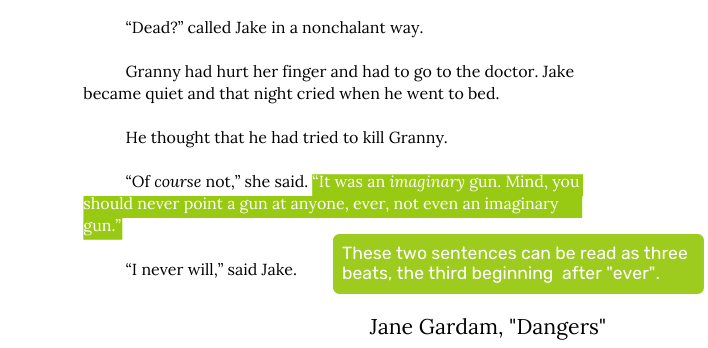
In theory, this sounds simple enough. In practice, however, it’s a bit more complicated than that, simply because dialogue conventions continue to change over time. There’s no way to condense “good dialogue” into a formula of three this, or two that. But if you’re just starting out and need a strict rule to help you along, then the Three-Beat Rule is a good place to begin experimenting.

FREE COURSE
How to Write Believable Dialogue
Master the art of dialogue in 10 five-minute lessons.
3. Use action beats
Let’s take a look at another kind of “beats” now — action beats.
Action beats are the descriptions of the expressions, movements, or even internal thoughts that accompany the speaker’s words. They’re always included in the same paragraph as the dialogue, so as to indicate that the person acting is also the person speaking.
Q: What are some techniques authors can use to introduce characters naturally through dialogue?
Suggested answer
When you're going to create a character through dialogue, what you want to do is provide the reader with information about this individual without interrupting the action for exposition.
One good way to do that is to think about how actual people reveal themselves in conversation: through what they say, the cadence of their speech, and what they focus on. Instead of telling us about what a character is sure, nervous, or resentful of, you can make those qualities evident in what they say.
A certain sort of character might answer quickly or deflect, while an unsure one might lie or offer more questions than answers. You can also include context of hinting—perhaps another character does something in response to an unexpected comment, or someone uses a nickname that suggests history. This allows the dialogue not just to define who the character is, but also how they exist in relationships with the world around them. It's generally more engaging to give little hints than to tell everything.
By piling personality, background, and relationships onto conversations, you create a sense of authenticity so that readers feel they're reading about a real person rather than getting a synopsis.
John is available to hire on Reedsy ⏺
Dialogue is one of the most powerful ways to introduce your characters and bring them to life for readers. When done well, it reveals personality, relationships, and motivations—all in a way that feels natural and engaging. Here are a few techniques to make character introductions through dialogue memorable, with examples from authors I’ve worked with.
Show personality through speech patterns
The way a character speaks—their tone, choice of words, and rhythm—can reveal a lot about who they are. In Losing Juliet by June Taylor, the dialogue between two adult female characters is a perfect example. One character is guarded and precise, while the other’s tone is more casual and assertive. This contrast instantly tells us about their personalities and sets up their complex dynamic. When editing, I often help authors create unique speech patterns that make each character’s voice distinctive.
Reflect relationships through dialogue
How characters speak to each other reveals their relationship dynamics. In Losing Juliet, Taylor uses subtle hints in the dialogue to convey past secrets and tension without spelling it all out. Readers sense the history and conflict between the characters, making the dialogue feel rich and layered. When I work with authors, I encourage exploring these nuances in relationships, showing rather than telling.
Reveal motivation through subtext
Great dialogue often goes beyond what’s explicitly said. In The Hanged Man Rises by Sarah Naughton, the children’s dialogue is filled with innocence and curiosity, yet it often hints at deeper fears and uncertainties. This subtle layer adds intrigue without needing direct exposition. I frequently work with authors to find opportunities for subtext, letting readers read between the lines to discover characters’ hidden motivations.
Show conflict and tension
Conflict in dialogue can reveal a character’s core traits. In The Hanged Man Rises, Naughton’s children’s dialogue shows both their vulnerability and resilience, heightening the story’s suspense. In Losing Juliet, conversations between the protagonists highlight simmering anger and unresolved issues, offering readers a glimpse of what drives each character. When editing, I encourage authors to think about how characters might speak differently under pressure—revealing who they are when emotions run high.
Balance dialogue with actions and reactions
Dialogue is most impactful when paired with physical cues. In Losing Juliet, Taylor often uses gestures and subtle actions to deepen the impact of what’s said (or left unsaid). These small cues add depth, creating a more immersive experience. I often advise authors to integrate these details, as they can make dialogue feel more real and relatable.
Reflect character growth in speech
As characters evolve, so should their dialogue. In The Hanged Man Rises, Naughton’s young characters’ dialogue changes as they face challenges, reflecting their growth over the course of the story. This shift makes their journey feel authentic, and I often encourage authors to consider these changes as they develop characters’ arcs.
Shelley is available to hire on Reedsy ⏺
How much or how little a character "speaks" says a lot about them. A dialect can also reveal where they are from. Broken English or a stutter can also say a lot. Dialogue is a great way to "show" and not "tell."
Melody is available to hire on Reedsy ⏺
The main thing to get across when introducing characters through dialogue is to write it so it feels natural. Constantly ask yourself if the way you're making them speak is the way regular people in those circumstances would speak. If it sounds too stilted or infodump-y, that's going to distance your reader from the character because they'll feel unreal, manufactured—just there to move the plot along.
Brett is available to hire on Reedsy ⏺
On a technical level, action beats keep your writing varied, manage the pace of a dialogue-heavy scene, and break up the long list of lines ending in ‘he said’ or ‘she said’.
But on a character level, action beats are even more important because they can go a level deeper than dialogue and illustrate a character’s body language.
When we communicate, dialogue only forms a half of how we get across what we want to say. Body language is that missing half — which is why action beats are so important in visualizing a conversation, and can help you “show” rather than “tell” in writing.
Here’s a quick exercise to practice thinking about body language in the context of dialogue: imagine a short scene, where you are witnessing a conversation between two people from the opposite side of a restaurant or café. Because it’s noisy and you can’t hear what they are saying, describe the conversation through the use of body language only.
Remember, at the end of the day, action beats and spoken dialogue are partners in crime. These beats are a commonly used technique so you can find plenty of examples — here’s one from Never Let Me Go by Kazuo Ishiguro.
4. Use ‘said’ as a dialogue tag
If there’s one golden rule in writing dialogue, it’s this: ‘said’ is your friend.
Yes, ‘said’ is nothing new. Yes, ‘said’ is used by all other authors out there already. But you know what? There’s a reason why ‘said’ is the king of dialogue tags: it works.
Pro-tip: While we cannot stress enough the importance of "said," sometimes you do need another dialogue tag. Download this free cheatsheet of 270+ other words for said to get yourself covered!

FREE RESOURCE
Get our Dialogue Tag Cheatsheet
Upgrade your dialogue with our list of 270 alternatives to “said.”
The thinking goes that ‘said’ is so unpretentious, so unassuming that it focuses readers’ attention on what’s most important on the page: the dialogue itself. As writer Elmore Leonard puts it:
“Never use a verb other than ‘said’ to carry dialogue. The line of dialogue belongs to the character; the verb is the writer sticking his nose in. But ‘said’ is far less intrusive than ‘grumbled,’ ‘gasped,’ ‘cautioned,’ ‘lied.’”
It might be tempting at times to turn towards other words for ‘said’ such as ‘exclaimed,’ or ‘declared,’ but my general rule of thumb is that in 90% of scenarios, ‘said’ is going to be the most effective dialogue tag for you to use while writing dialogue.
5. Write scene-based dialogue
So now that we have several guidelines in place, this is a good spot to pause, reflect, and say that there’s no wrong or right way to write dialogue. It depends on the demands of the scene, the characters, and the story. Great dialogue isn’t about following this or that rule — but rather learning what technique to use when.
Q: What advice would you give to someone who wants to become a full-time writer?
Suggested answer
Write. Write every day. Work on your craft. Join a writers group and share your writing with others, get feedback, and provide feedback on their writing.
Writing is like exercise. You have to work on it consistently and build it up over time.
Maria is available to hire on Reedsy ⏺
If you stick to one rule the whole time — i.e. if you only use ‘said,’ or you finish every dialogue line with an action beat — you’ll wear out readers. Let’s see how unnaturally it plays out in the example below with Sophie and Ethan:
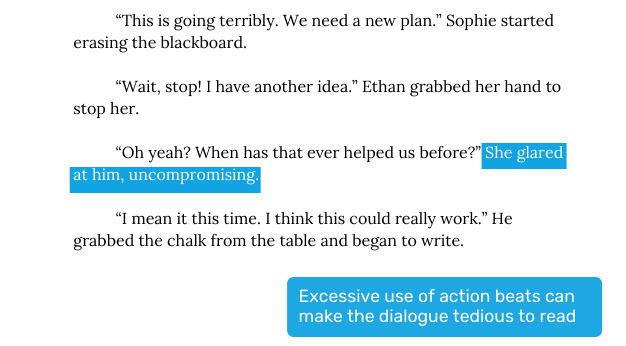
All of which is to say: don’t be afraid to make exceptions to the rule if the scene asks for it. The key is to know when to switch up your dialogue structure or use of dialogue tags or action beats throughout a scene — and by extension, throughout your book.
Q: Which authors are known for exceptional dialogue, and what techniques set them apart?
Suggested answer
I like Nick Hornby for providing realistic dialogue for male characters. He can get into the male mind and convey what men are thinking, in an honest and real way.
Melody is available to hire on Reedsy ⏺
You can't go wrong with Robert B. Parker's sharp, punchy dialogue. Chuck Palahniuk is also very good at keeping dialogue crisp. For both of these writers, they don't tend to use a ton of attributive dialogue tags—especially when there're only two people in a scene—and accompanying actions while dialogue is occurring is kept to a minimum, which retains that punchiness.
Brett is available to hire on Reedsy ⏺
6. Model any talk on real life
Dialogue isn’t always about writing grammatically perfect prose. The way a person speaks reflects the way a person is — and not all people are straight-A honor students who speak in impeccable English. In real life, the way people talk is fragmented, and punctuated by pauses.
That’s something that you should also keep in mind when you’re aiming to write authentic dialogue.
It can be tempting to think to yourself, “Oh, I’ll try and slip in some exposition into my dialogue here to reveal important background information.” But if that results in an info-dump such as this — “I’m just going to the well, Mother — the well that my brother, your son, tragically fell down five years ago” — then you’ll probably want to take a step back and find a more organic, timely, and digestible way to incorporate that into your story.
For an example of how to do exposition-within-dialogue right while keeping the dialogue real to life, look to The Godfather, where readers get their first look at the Corleones through Michael's introduction of his family to his girlfriend.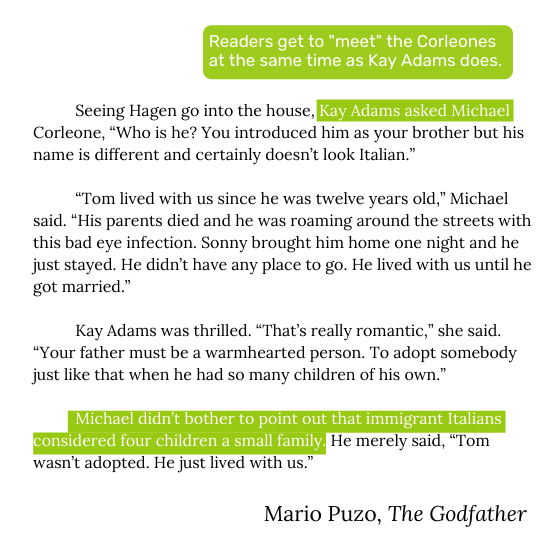
Kay Adams is Michael’s date at his sister’s wedding in this scene. Her interest in his family is natural enough that the expository conversation doesn’t feel shoehorned in.
7. Differentiate character voices
A distinctive voice for each character is perhaps the most important element to get right in dialogue. Just as no one person in the world talks the same as each other, no one person in your book should also talk similarly.
To get this part of writing dialogue down pat, you need to start out by knowing your characters inside out. How does your character talk? Do they come with verbal quirks? Non-verbal quirks?
Q: What does it mean to create an “original” character in fiction?
Suggested answer
Original characters are those who are subverted stereotypes, who have things about them which are conflicting, who go against the grain in some way and who speak, think and react in ways that are not predictable.
Vanessa is available to hire on Reedsy ⏺
An original character feels and seems real and believable. They do not closely resemble a character that is well known in literature and have their own unique personality, desires, and set of circumstances.
Melody is available to hire on Reedsy ⏺
I think writing an original character just means that when a reader engages with that character, no other particular character comes to mind. Bit of a pithy answer, I know, but there you go. 😉
Brett is available to hire on Reedsy ⏺
Jay Gatsby’s “old sport,” for example, gives him a distinctive, recognizable voice. It stands out because no one else has something as memorable about their speech. But more than that, it reveals something valuable about Gatsby’s character: he’s trying to impersonates a gentleman in his speech and lifestyle.
Likewise, think carefully about your character’s voice, and use catchphrases and similar quirks when they can say something about your character.
🖊️
Which famous author do you write like?
Find out which literary luminary is your stylistic soulmate. Takes one minute!
8. "Show, don't tell" information in conversation
“Show, don’t tell” is one of the most oft-repeated rules in writing, and a conversation on the page can be a gold mine for “showing.”
Authors can use action beats and descriptions to provide clues for readers to read between the lines. Let’s revisit Sophie and Ethan in this example:
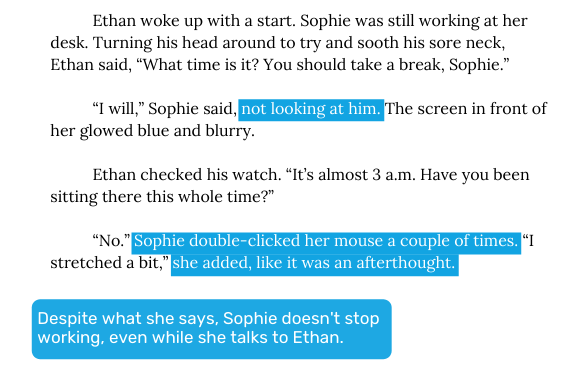
While Sophie claims she hasn’t been obsessing over this project all night, the actions in between her words indicate there’s nothing on her mind but work. The result is that you show, through the action beats vs. the dialogue, Sophie being hardworking—rather than telling it.

FREE COURSE
Show, Don't Tell
Master the golden rule of writing in 10 five-minute lessons.
9. Delete superfluous words
As always when it comes to writing a novel: all roads lead back to The Edit, and the dialogue you’ve written is no exception.
So while you’re editing your novel at the end, you may find that a “less is more” mentality will be helpful. Remember to cut out the unnecessary bits of dialogue, so that you can focus on making sure the dialogue you do keep matters. Good writing is intentional and purposeful, always striving to keep the story going and readers engaged. The importance lies in quality rather than quantity.
Q: What are the most common craft mistakes new authors make?
Suggested answer
One of the biggest mistakes I see from new authors is that they finish writing their manuscript and then they think they are done and ready for an editor to go through and review.
Writers need to be their own editors first. Because there are so many potential new authors every day, it's imperative that writers go back and edit their work thoroughly. That means reading, and rereading what they've written to understand how their characters develop through their novel, or how the topics that they brought up in chapter two are refined and built upon in chapter nine. Through that reading process, writers should be editing their work as they find pieces that aren't strong enough or need to be altered to make a better overall manuscript.
Matt is available to hire on Reedsy ⏺
The most common writing mistake I see from first-time authors is cramming too much into the first chapter. Your first chapter is a meet and greet, where you establish credibility, likability, and optimism that the book is worth the reader's time. Hook the reader, show your personality, but don't dump all your knowledge on them at the beginning of the book. Take them on an interesting, helpful journey,
Mike is available to hire on Reedsy ⏺
One point I haven’t addressed yet is repetition. If used well (i.e. with clear intention), repetition is a literary device that can help you build motifs in your writing. But when you find yourself repeating information in your dialogue, it might be a good time to revise your work.
For instance, here’s a scene with Sophie and Ethan later on in the story:
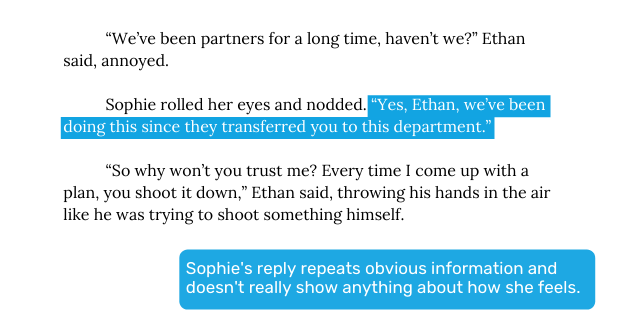
As I’ve mentioned before, good dialogue shows character — and dialogue itself is a playground where character dynamics play out. If you write and edit your dialogue with this in mind, then your dialogue will be sharper, cleaner, and more organic.
I know that writing dialogue can be intimidating, especially if you don’t have much experience with it. But that should never keep you from including it in your work! Just remember that the more you practice — especially with the help of these tips — the better you’ll get.
And once you’re confident with the conversational content you can conjure up, follow along to the next part of our guide to see how you can punctuate and format your dialogue flawlessly.



